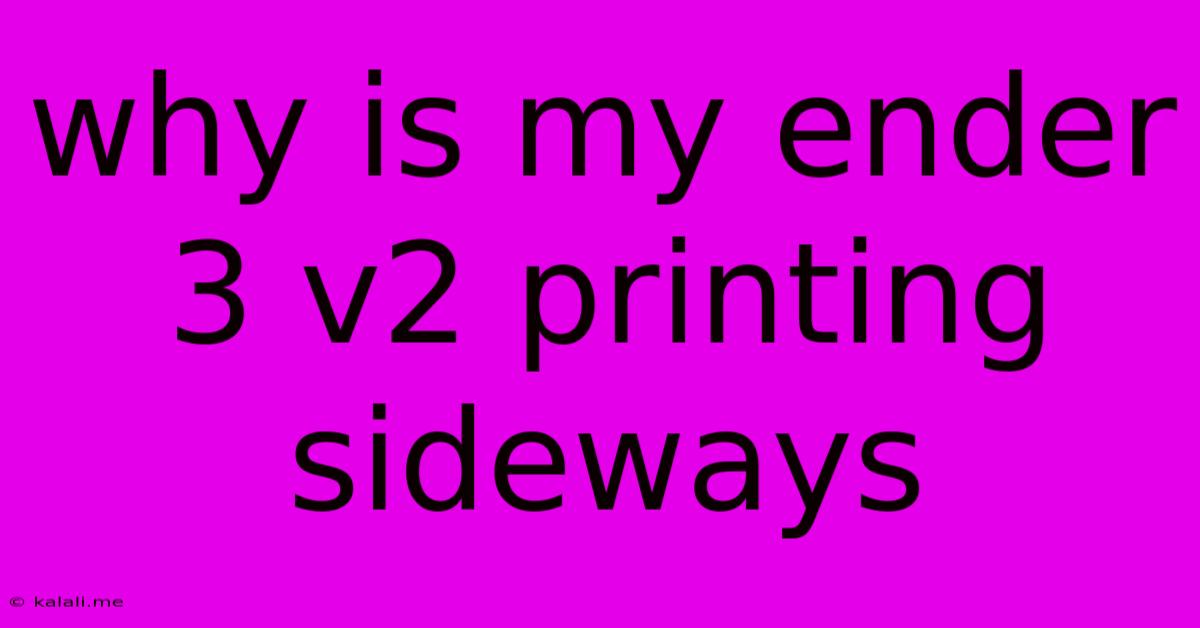Why Is My Ender 3 V2 Printing Sideways
Kalali
May 31, 2025 · 3 min read

Table of Contents
Why Is My Ender 3 V2 Printing Sideways? Troubleshooting Common Causes
Are you frustrated because your Ender 3 V2 is stubbornly printing your prints sideways, ruining perfectly good filament? This common issue can stem from several sources, and diagnosing the problem correctly is key to getting back to successful 3D printing. This article will guide you through the most frequent culprits and offer practical solutions to get your prints oriented correctly.
Understanding the Problem: A sideways print means your layers aren't stacking vertically as intended; instead, they're laying down horizontally or at an angle. This isn't a printer malfunction, but rather a misconfiguration or issue with the print setup.
1. Incorrect Model Orientation in Slicing Software: The Most Common Culprit
The most frequent reason for sideways prints is simply incorrect model orientation in your slicing software (like Cura, PrusaSlicer, or Simplify3D). Before even starting a print, you must ensure your model is correctly aligned within the software. The model's orientation dictates how the layers are built. If it's tilted or rotated incorrectly in the slicer, the print will follow suit.
- Solution: Double-check your model's orientation within your slicing software. Most slicers offer visual tools (rotation and positioning tools) to easily adjust this. Make sure the base of your model is sitting flat on the print bed, aligned as you intend it to be printed. Pay close attention to the preview before sending the G-code to the printer.
2. Bed Leveling Issues: A Foundation for Success
An improperly leveled print bed is another frequent cause of printing problems, including sideways prints. A bed that's not level leads to inconsistent layer adhesion, potentially causing layers to shift or peel away.
- Solution: Carefully level your print bed using the manual leveling knobs or auto-bed leveling (ABL) if equipped. Several methods exist; research the best technique for your Ender 3 V2. Consistent first-layer adhesion is crucial. A slightly higher first layer height (in your slicer settings) might also help compensate for minor bed leveling imperfections.
3. Z-Axis Binding or Problems: Ensuring Smooth Vertical Movement
A binding Z-axis can prevent the print head from moving smoothly up and down, leading to tilted or skewed layers. This can be due to various issues like:
-
Tight screws: Over-tightened screws in the Z-axis assembly can restrict movement.
-
Worn or damaged parts: Check for any damage or wear to the Z-axis rods, bearings, or other components.
-
Belt tension: Too tight a Z-axis belt can also interfere with smooth movement.
-
Solution: Carefully check all Z-axis components for any issues listed above. Loosen screws slightly if necessary, replace worn parts if required, and ensure proper belt tension. Lubricating moving parts can improve smoothness.
4. Incorrect G-Code: Double Check Your File
While less common, errors in the G-code itself can cause printing issues. This could be due to slicer glitches or corrupted files.
- Solution: Try generating the G-code again from your slicer. Make sure all your settings are correct and re-slice the model. If the problem persists, consider downloading a fresh copy of your 3D model to rule out any corruption in the original file.
5. Firmware Problems: A Deeper Dive
In rarer cases, firmware issues could contribute to printing problems. While less likely to cause solely sideways printing, it's worth considering if other issues are ruled out.
- Solution: Check for firmware updates for your Ender 3 V2. Flashing new firmware should only be attempted if you're comfortable with the process and understand the potential risks.
By systematically addressing these points, you should be able to diagnose why your Ender 3 V2 is printing sideways and get your prints back on track. Remember to always check the basics first – model orientation and bed leveling are often the culprits. If the problem persists, seek help from the active and supportive 3D printing community online.
Latest Posts
Latest Posts
-
How To Prevent Loss Overflow In Bf16
Jun 02, 2025
-
How To Prove A Limit Exists
Jun 02, 2025
-
How To Fix Water Hammer In Shower
Jun 02, 2025
-
What Is The Difference Between Latex And Acrylic Paint
Jun 02, 2025
-
Can You Use Led Lights In Incandescent Fixtures
Jun 02, 2025
Related Post
Thank you for visiting our website which covers about Why Is My Ender 3 V2 Printing Sideways . We hope the information provided has been useful to you. Feel free to contact us if you have any questions or need further assistance. See you next time and don't miss to bookmark.